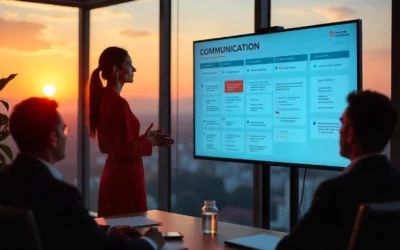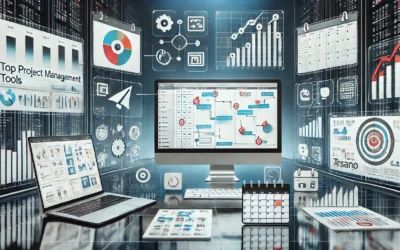The Challenge of Productive Meetings
Ever felt trapped in an endless cycle of meetings that seem to go nowhere? You’re not alone. As a new project manager, you might find yourself wondering if there’s a secret recipe for running effective project meetings that actually drive progress rather than hinder it.
Picture this: You’re leading a meeting with your project team. The air is thick with anticipation—or perhaps apprehension. The success of your project hangs in the balance, and how you conduct this meeting could significantly impact your outcomes. With the right tools and techniques, you can transform your project meetings from dreaded time-consumers into dynamic, productive sessions that genuinely move your project forward.
This comprehensive guide will equip you with practical strategies to plan, conduct, and follow up on project meetings that deliver results—whether you’re planning a kick-off, conducting a status review, or problem-solving with stakeholders.
Understanding Project Meeting Types
Before diving into meeting management techniques, it’s essential to understand the different types of project meetings you might lead throughout the project lifecycle:
Project Kick-off Meeting
The kick-off meeting marks the official start of your project. This critical session:
- Introduces team members and clarifies roles
- Establishes project goals, scope, and deliverables
- Reviews the project timeline and key milestones
- Outlines communication protocols and expectations
- Addresses initial questions and concerns
A well-executed kick-off sets the tone for the entire project and ensures everyone starts with aligned expectations.
Regular Team Meetings
These recurring meetings serve as the heartbeat of your project, keeping everyone synchronised and informed. They typically:
- Provide a forum for team members to share updates
- Identify emerging issues or roadblocks
- Coordinate interdependent activities
- Maintain team cohesion and motivation
The frequency of these meetings depends on your project’s complexity, pace, and team preferences.
Project Status Meetings
Status meetings focus specifically on monitoring project progress against the plan. Key components include:
- Reviewing completed tasks and deliverables
- Assessing progress against the schedule and budget
- Identifying variances and determining corrective actions
- Updating risk assessments
- Communicating progress to key stakeholders
Effective status meetings provide an accurate snapshot of project health and enable timely course corrections.
Stakeholder Meetings
Meetings with project stakeholders require careful preparation and facilitation. These sessions:
- Update stakeholders on project progress
- Gather feedback and address concerns
- Secure decisions or approvals for proceeding
- Manage expectations and build support
- Navigate political dynamics that may impact the project
Stakeholder management is crucial for project success, making these meetings particularly important.
Problem-Solving Sessions
When your project encounters significant challenges, dedicated problem-solving meetings help the team:
- Define and analyse the problem
- Identify root causes
- Generate potential solutions
- Evaluate options and select the best approach
- Develop implementation plans
These focused sessions prevent problems from derailing regular team meetings.
Project Review Meetings
Conducted at key milestones or project completion, review meetings:
- Evaluate deliverables against requirements
- Document lessons learned
- Recognise team achievements
- Identify process improvements
- Create knowledge assets for future projects
Reviews provide closure on project phases and contribute to organisational learning.
Agile Meetings
For projects using Agile methodologies, specific meeting formats include:
- Sprint Planning: Setting objectives and tasks for the upcoming sprint
- Daily Scrums/Stand-ups: Brief daily synchronisation meetings
- Sprint Reviews: Demonstrating completed work to stakeholders
- Sprint Retrospectives: Reflecting on process improvements
These standardised meetings support the iterative, incremental approach of Agile frameworks.
Creating an Effective Meeting Agenda
Your meeting agenda serves as the roadmap for productive discussions. Here’s how to craft one that keeps participants focused and engaged:
Elements of a Strong Agenda
A comprehensive meeting agenda should include:
- Meeting purpose and objectives: Clearly state what the meeting aims to accomplish
- Discussion topics: List specific items to be covered, in priority order
- Time allocations: Assign realistic timeframes for each agenda item
- Required preparation: Note any pre-reading or tasks participants should complete beforehand
- Participant roles: Indicate who will lead or contribute to specific discussions
- Decision points: Highlight items requiring decisions or approvals
- Meeting logistics: Include date, time, location, and connection details
Agenda Distribution Best Practices
To maximise the agenda’s effectiveness:
- Distribute it at least 24-48 hours before the meeting
- Encourage participants to suggest agenda modifications or additions
- Ask presenters to confirm their readiness to address their topics
- Include relevant documents or links as attachments
- Format the agenda for easy reference during the meeting
Sample Project Status Meeting Agenda
Project Alpha: Weekly Status Meeting
Tuesday, 10 May 2023, 10:00-11:00, Conference Room B
Objectives:
- Review progress on key deliverables
- Address current issues and risks
- Align on next week's priorities
Agenda:
10:00-10:05 - Welcome and recap of previous actions (Project Manager)
10:05-10:25 - Work stream updates (Team Leads, 4 minutes each)
10:25-10:40 - Critical issues discussion (All)
10:40-10:50 - Risk review (Risk Officer)
10:50-11:00 - Next steps and action items (Project Manager)
Preparation required:
- Team Leads: Update your status reports by Monday 5 PM
- All: Review the updated risk register before the meeting
A well-structured agenda like this sets clear expectations and helps keep the meeting on track.
Meeting Participant Management
Just as every musician in an orchestra serves a purpose, every participant in your meeting should have a clear role. Efficient meetings include the right people—no more, no less.
Identifying Essential Participants
When determining who should attend, consider:
- Who has information necessary for the discussion?
- Who needs to be part of the decision-making process?
- Who will be responsible for implementing the actions?
- Who has authority over resources required?
- Who will be significantly impacted by the meeting outcomes?
Defining Participant Roles
Clarify roles to enhance meeting productivity:
- Meeting Chair/Facilitator: Guides the discussion and ensures meeting objectives are met
- Timekeeper: Monitors time allocations and signals when to move on
- Note-taker: Records key points, decisions, and action items
- Subject Matter Experts: Provide specialised knowledge on specific topics
- Decision-makers: Have authority to approve proposals or allocate resources
- Team members: Contribute to discussions from their area of responsibility
Managing Meeting Size
Research consistently shows that meeting effectiveness decreases as the participant count increases. Consider these guidelines:
- For decision-making meetings, limit attendance to 8 people or fewer
- For information-sharing meetings, keep the group under 20 if possible
- For larger necessary meetings, use strategies like breakout groups to maintain engagement
- Consider the “two-pizza rule” popularised by Amazon: If it takes more than two pizzas to feed the group, the meeting is too large
The RACI Approach
Use the RACI (Responsible, Accountable, Consulted, Informed) framework from stakeholder management to determine meeting involvement:
- Responsible & Accountable: Should attend the full meeting
- Consulted: Might attend portions relevant to their input
- Informed: Receive meeting notes rather than attending
This targeted approach respects everyone’s time and keeps meetings focused.
Mastering Meeting Facilitation
As the meeting facilitator, your role is to guide the discussion and ensure productive outcomes. Here are essential facilitation techniques:
Setting the Stage
Start strong by:
- Beginning precisely on time (regardless of who’s missing)
- Clearly restating the meeting purpose and desired outcomes
- Reviewing the agenda and time allocations
- Establishing or reminding participants of meeting ground rules
- Creating an atmosphere of psychological safety where all input is valued
Maintaining Momentum
Keep the discussion flowing productively by:
- Actively monitoring progress against the agenda
- Using gentle but firm redirections when conversations veer off-topic
- Employing the “parking lot” technique for important but tangential issues
- Summarising key points before moving to the next agenda item
- Being mindful of energy levels and calling breaks when needed
Encouraging Balanced Participation
Ensure all voices are heard by:
- Calling on quieter participants for their perspective
- Using techniques like round-robin input for important topics
- Tactfully interrupting dominant speakers to bring others in
- Acknowledging valuable contributions to encourage further participation
- Using small group breakouts to increase participation in larger meetings
Handling Difficult Situations
Address common meeting challenges by:
- Mediating disagreements by focusing on facts and project objectives
- Acknowledging emotions without letting them derail the discussion
- Stepping in when conversations become personal rather than professional
- Taking contentious issues offline when they cannot be resolved productively
- Being prepared to table topics that require more information or cooler heads
Decision-Making Approaches
Clarify how decisions will be made:
- Consensus: Everyone can support and commit to the decision
- Majority vote: Democratic approach for less critical decisions
- Consultative: Input from all, decision by the accountable person
- Command: Decision by the authority figure with or without discussion
Different decisions may warrant different approaches, but always make the method explicit.
Conducting Effective Project Status Meetings
Status meetings are likely your most frequent project meetings. Here’s how to make them consistently productive:
Standardised Structure
Implement a consistent format that includes:
- Quick progress overview using visual tools
- Focused attention on exceptions and issues rather than routine updates
- Forward-looking discussion of upcoming work and potential challenges
- Clear decisions on any needed adjustments to the plan
Visual Management Tools
Enhance understanding through visual aids:
- Gantt charts for schedule tracking
- Burndown or burn-up charts for work completion trends
- Red/Amber/Green (RAG) status indicators for quick health assessments
- Risk registers highlighting key concerns
- Financial variance reports for budget monitoring
Visual tools make status easier to understand and discuss meaningfully.
Status Meeting Efficiency Tips
Maximise the value of status meetings by:
- Collecting updates asynchronously before the meeting when possible
- Focusing discussion on variances, risks, and decisions needed
- Following a consistent sequence for work stream updates
- Maintaining a running action item log visible to all participants
- Keeping the meeting tempo brisk to maintain engagement
Well-run status meetings provide clear visibility into project health while respecting everyone’s time.
Capturing and Managing Action Items
The true value of most meetings lies in the actions they generate. Implement these practices to ensure accountability:
Effective Action Item Documentation
For each action item, record:
- A clear, specific description of the task to be completed
- The name of the person responsible for completion
- A specific deadline for completion
- Any resources or support required
- How completion will be verified or reported
Vague action items like “Look into the issue” should be refined to specific, measurable tasks.
Action Item Tracking Systems
Establish a system for tracking action items:
- Maintain a master action item log accessible to all team members
- Update the status of items regularly, not just at meetings
- Send reminders approaching deadlines
- Begin each meeting by reviewing outstanding items
- Close completed items with acknowledgment of the achievement
Consider using your project management software to track action items alongside other project tasks.
Sample Action Item Format
CopyAction ID: A-047
Description: Complete the security assessment for the new vendor portal
Owner: Sarah Chen
Due Date: 15 May 2023
Resources Needed: IT security checklist, vendor documentation
Verification Method: Report findings at next steering committee
Status: In progress - 50% completeThis level of detail prevents misunderstandings and enables effective follow-up.
Optimising Remote and Hybrid Meetings
With distributed teams increasingly common, mastering remote and hybrid meeting facilitation is essential:
Technology Considerations
Set the foundation for success with:
- Reliable video conferencing platforms with necessary features
- Clear audio equipment that captures all participants
- Sufficient bandwidth for video transmission
- Backup plans for technology failures
- Advance testing of all systems
Remote Meeting Engagement Strategies
Counter the challenges of virtual settings by:
- Using video whenever possible to maintain human connection
- Starting with a brief check-in to build rapport
- Employing interactive tools like polls and virtual whiteboards
- Calling on people by name to maintain attention
- Using the chat function for questions and parallel discussions
- Taking more frequent breaks (5 minutes every 45-60 minutes)
Hybrid Meeting Best Practices
When some participants are in-room and others remote:
- Use room cameras that show all in-person participants
- Position screens so in-room participants can see remote colleagues
- Have a designated person monitor the chat for remote participants
- Use digital collaboration tools that everyone can access equally
- Be vigilant about including remote participants in discussions
With proper planning, remote and hybrid meetings can be just as effective as in-person ones.
Continuous Improvement for Meeting Excellence
Even the most skilled meeting facilitators continue to refine their approach. Implement these practices for ongoing enhancement:
Meeting Retrospectives
Periodically evaluate meeting effectiveness by asking:
- Did we achieve our meeting objectives?
- Was the time well-spent for all participants?
- Did we have the right people in attendance?
- Was the discussion balanced and inclusive?
- How could we improve our next similar meeting?
Consider dedicating the last 5 minutes of important meetings to a quick evaluation.
Gathering Participant Feedback
Collect insights from meeting participants through:
- Simple surveys after significant meetings
- Anonymous feedback mechanisms for honest input
- Direct questions about meeting value and experience
- Observations of engagement and participation patterns
Use this feedback to refine your approach continuously.
Meeting Metrics to Track
Consider measuring:
- Meeting frequency and duration trends
- Ratio of discussion to decision-making time
- Action item completion rates
- Participant satisfaction scores
- Percentage of meetings starting and ending on time
Metrics provide objective insights into your meeting management effectiveness.
Your Meeting Management Checklist
Use this checklist to ensure your project meetings consistently deliver value:
Before the Meeting
- Clarify the meeting purpose and desired outcomes
- Determine if a meeting is truly necessary
- Identify essential participants
- Create and distribute a clear agenda in advance
- Assign preparation tasks to participants
- Set up the meeting space or virtual environment
- Test technology and prepare visual aids
During the Meeting
- Start and end on time
- Review the agenda and objectives
- Facilitate balanced discussion
- Keep conversations focused on agenda items
- Document key decisions and action items
- Regularly summarise progress and next steps
- Manage time allocations actively
After the Meeting
- Distribute meeting notes promptly
- Assign and communicate action items
- Follow up on action item progress
- Gather feedback on meeting effectiveness
- Apply lessons learned to future meetings
Conclusion: Becoming a Meeting Maestro
Effective project meetings don’t happen by accident—they result from thoughtful planning, skilled facilitation, and consistent follow-through. By implementing the strategies outlined in this guide, you’ll transform your project meetings from necessary evils into powerful tools that drive project success.
Remember that meeting management is a skill that improves with practice. Don’t get discouraged if your first few attempts aren’t perfect. Keep refining your approach based on experience and feedback, and soon you’ll be known for running meetings that team members actually look forward to attending.
Your project success depends not just on what happens between meetings, but on how effectively you use meeting time to align efforts, solve problems, and maintain momentum. Master this critical skill, and you’ll distinguish yourself as a project manager who truly delivers results.
Enhance Your Project Management Skills
At Project Success Hub, we specialise in equipping new project managers with the practical skills needed for success. Our comprehensive training programmes include advanced techniques for meeting facilitation, stakeholder management, and team leadership.
Ready to take your project management capabilities to the next level? Contact us today to learn about our personalised training options and how we can help you excel in your project management career.






0 Comments